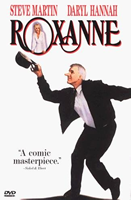Recommended Screenwriters
The Comedy Brainstorm Session
- September 22, 2010
- Posted by: HalCroasmun
- Category: Articles

 When producers read a comedy screenplay, they are looking for one thing — DO THEY LAUGH? And then, how often do they laugh?
When producers read a comedy screenplay, they are looking for one thing — DO THEY LAUGH? And then, how often do they laugh?
You could also make them smile, chuckle, smirk, etc. But the one thing that you absolutely have to do is cause them to laugh out loud. And if you really want to be in demand, give them the ultimate high — the deep belly laugh.
How do you do that?
To “write funny,” you must “think funny.” Makes sense, doesn’t it?
Today, we’ll watch part of a comedy brainstorm session. It will be delivered by one of the masters of stand-up and film comedy — Steve Martin.
You will clearly see that he is using a process to generate comedy. Some people call him lucky or extremely creative, but for anyone who has done standup comedy, you know that Steve Martin understands what makes something funny…and that type of thinking naturally produces comedy.
This scene is from the movie ROXANNE, written by Edmond Rostand and Steve Martin. In it, you’ll see a brainstorm session. Before someone emails me, I don’t recommend that you put a whole series of punchlines in a row like Steve does here. But it is worth studying in order to gain a deeper understanding of the comedy writing process.
I’ll set it up for you…
Charley (Steve Martin) is the Chief of the fire department of a little town. He also has a huge nose that has kept him out of a relationship and has already caused a number of fights. Charley is also pretty good at Karate.
In this scene, a STOCKY GUY has challenged him in front of a bar full of people. The stocky guy wants to kick Charley’s ass, but Charley turned it into a game of “Who can think up the best nose insult?”
Notice how many different punchlines Steve Martin comes up for one insult. Also, pay attention to my notes. On some of them, I made a note of the specific type of punchline he used.
From ROXANNE
Edmond Rostand – Writer (play “Cyrano de Bergerac”), Steve Martin – Writer (screenplay)
INT. BAR — NIGHT
Charley grabs a dart from the dartboard.
CHARLEY
Whatever number you hit, that’s
how many I’ll think up.
The Stocky Guy hits 20.
CHARLEY
Twenty! Shit. Two out of three.
He retrieves the dart and returns it to the Guy, who instantly hits 20 again.
STOCKY GUY
Darts champion. Denver. 1987.
The bar cheers Charley on. Charley delivers each insult at the Stocky guy.
CHARLEY
Alright, twenty somethings better.
Start with obvious. Excuse me, is
that your nose or did a bus park on
your face?
The bar audience laughs.
CHARLEY
Meteorological. Everybody take cover,
she’s going to blow!
Note: Here, he is simply finding ways his nose could be described through a metaphor. The bus punchline is presented through a question and the next is presented through a warning.
(Audience laughs)
Fashionable. You know, you could
de-emphasize your nose if you wore
something larger, like Wyoming.
Note: Notice the exaggeration?
Personal. Well, here we are. Just the
three of us.
Note: Incongruent conclusion.
(Audience laughs)
Punctual. Alright, your nose was on
time, but you were fifteen minutes late!
(Audience laughs)
Note: This is a bit of a reversal, but more than that, it’s exaggeration.
Envious. Oh, I wish I were you. Gosh, to
be able to smell your own ear.
(Audience laughs)
Naughty. Pardon me, sir. Some of the
ladies have asked if you wouldn’t mind
putting that thing away.
(Audience laughs)
Note: You could call this one a metaphor. What “thing” is he putting away? But it’s also an absurd request.
Philosophical. You know, it’s not the size
of a nose that’s important, it’s what’s in
it that matters.
(Audience laughs)
Humorous: Laugh and the World laughs
with you. Sneeze and it’s goodbye Seattle.
(Audience laughs)
Note: Both of these are based on cliches that have then been altered in an incongruent way.
Commercial: Hi, I’m Earl Shibe and I can
paint that nose for $39.95.
(Audience laughs)
Note: That one is a parody of a TV commercial.
In the Comedy Writing for Screenplays Class, I go through all 20, along with explanations about how to apply each. But for now, just notice how Steve Martin was brainstorming comedy. The process you’ve just witnessed is one of the ways great comedy lines are created.
If this seems complicated, you’ll be surprised to learn that it is just a matter of understanding a few important steps. Thinking funny doesn’t mean laughing all the time. It means you understand and think through the “structure of comedy.”
Once you can think through the structure of comedy, you’ll be able to generate real laughs consistently throughout your script and a few times the reader will experience hilarious, rolling-on-the-floor, gut-busting scenes and punchlines that will establish you as a pro.
